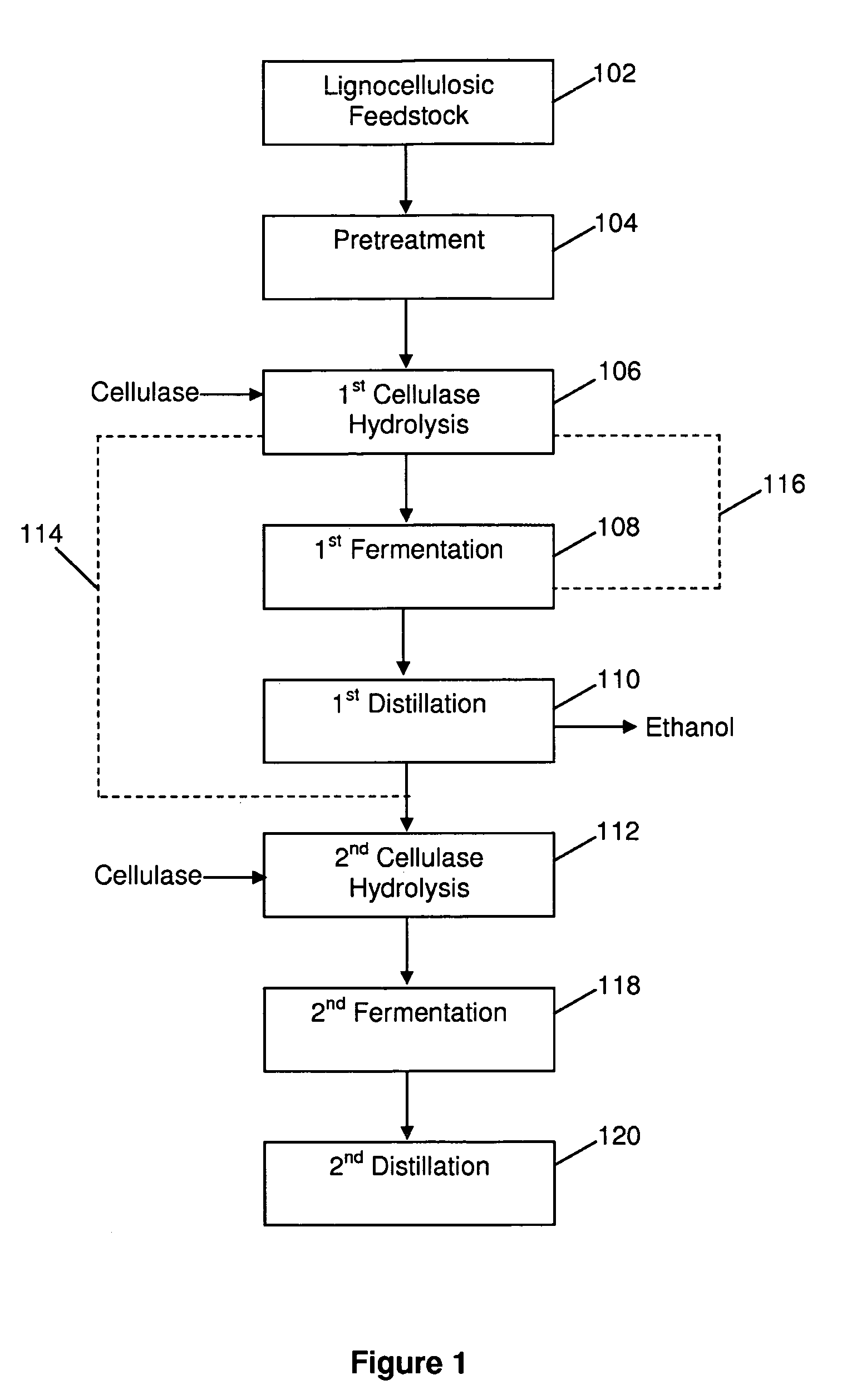Method for the production of alcohol from a pretreated lignocellulosic feedstock
a technology of lignocellulosic feedstock and alcohol, which is applied in the direction of peptides, peptide sources, separation processes, etc., can solve the problems of low yield, different processing steps for producing glucose from corn or other feedstocks containing high levels of starch, and reduce the amount of alcohol produced by the process, so as to increase the amount of fermentable sugar, increase the yield of fermentable sugar, and improve the yield
- Summary
- Abstract
- Description
- Claims
- Application Information
AI Technical Summary
Benefits of technology
Problems solved by technology
Method used
Image
Examples
example 1
Enzymatic Hydrolysis after Simulated Distillation
[0091]Wheat straw was pretreated at 185° C., pH 1.0 with 1 wt % sulfuric acid in a manner consistent with Foody, U.S. Pat. No. 4,461,648 After pretreatment, the straw was washed with water and stored in a 4° C. refrigerator. The washed, pretreated wheat straw was hydrolyzed with cellulase enzymes made by a strain of Trichoderma reesei that was genetically modified to overexpress β-glucosidase and cultivated in a submerged culture fermentation, as described by White and Hindle, (U.S. Pat. No. 6,015,703). The stock of enzyme was concentrated by ultrafiltration to a final concentration of 133 Filter Paper Units per mL (165 g protein / L) and stored refrigerated. The cellulose hydrolysis was carried out in 50 mM KH2PO4 buffer, pH 5.0, in a total volume of 50 mL in screw top flasks at a cellulose concentration of 2.53%. The cellulase enzyme was added at a dose of 3 mg protein per gram cellulose (3 mg / g), and the hydrolysis was conducted at 5...
example 2
Comparative Example without Simulated Distillation
[0099]In order to determine whether or not the enhanced hydrolysis observed was due to simulated distillation, the hydrolysis was conducted as in the first run of Example 1 (See FIG. 2A), but the fermentation and simulated distillation were omitted. Furthermore, the wheat straw contained 2.5% cellulose and fresh cellulase enzyme at a dose of 30 mg / g was added at 24 hours.
[0100]As shown in FIG. 7, when 30 mg / g of fresh enzyme was added to the flask at 24 hours, the cellulose conversion did not improve significantly. When comparing FIG. 7 to FIGS. 5 and 6 it can be seen that the simulated distillation did, in fact, significantly improve the cellulose hydrolysis.
example 3
Enzymatic Hydrolysis after Distillation
[0101]Wheat straw 102 was pretreated 104 at 210° C., pH 1.55 with 0.25 wt % sulfuric acid in a manner consistent with Foody, U.S. Pat. No. 4,461,648 (the entire contents of which is incorporated herein by reference) according to the process flow diagram shown in FIG. 1. After pretreatment, the straw was dewatered by an Alfa Laval decanter centrifuge to 25% solids content. The decanter cake was combined with centrate to a concentration of 13% solids, and then pumped into a hydrolysis mix tank of volume 5000 liters.
[0102]In the mix tank, the slurry was cooled to 50° C. The pH was adjusted to 5.0 by adding 30% ammonium hydroxide solution. Cellulase enzyme was then added to the slurry. The cellulase was made by a strain of Trichoderma reesei that was genetically modified to overexpress beta-glucosidase and cultivated in a submerged culture fermentation, as described by White and Hindle, U.S. Pat. No. 6,015,703 (the entire content of which is incorp...
PUM
| Property | Measurement | Unit |
|---|---|---|
| temperature | aaaaa | aaaaa |
| temperature | aaaaa | aaaaa |
| slurry retention time | aaaaa | aaaaa |
Abstract
Description
Claims
Application Information
 Login to View More
Login to View More - R&D
- Intellectual Property
- Life Sciences
- Materials
- Tech Scout
- Unparalleled Data Quality
- Higher Quality Content
- 60% Fewer Hallucinations
Browse by: Latest US Patents, China's latest patents, Technical Efficacy Thesaurus, Application Domain, Technology Topic, Popular Technical Reports.
© 2025 PatSnap. All rights reserved.Legal|Privacy policy|Modern Slavery Act Transparency Statement|Sitemap|About US| Contact US: help@patsnap.com



